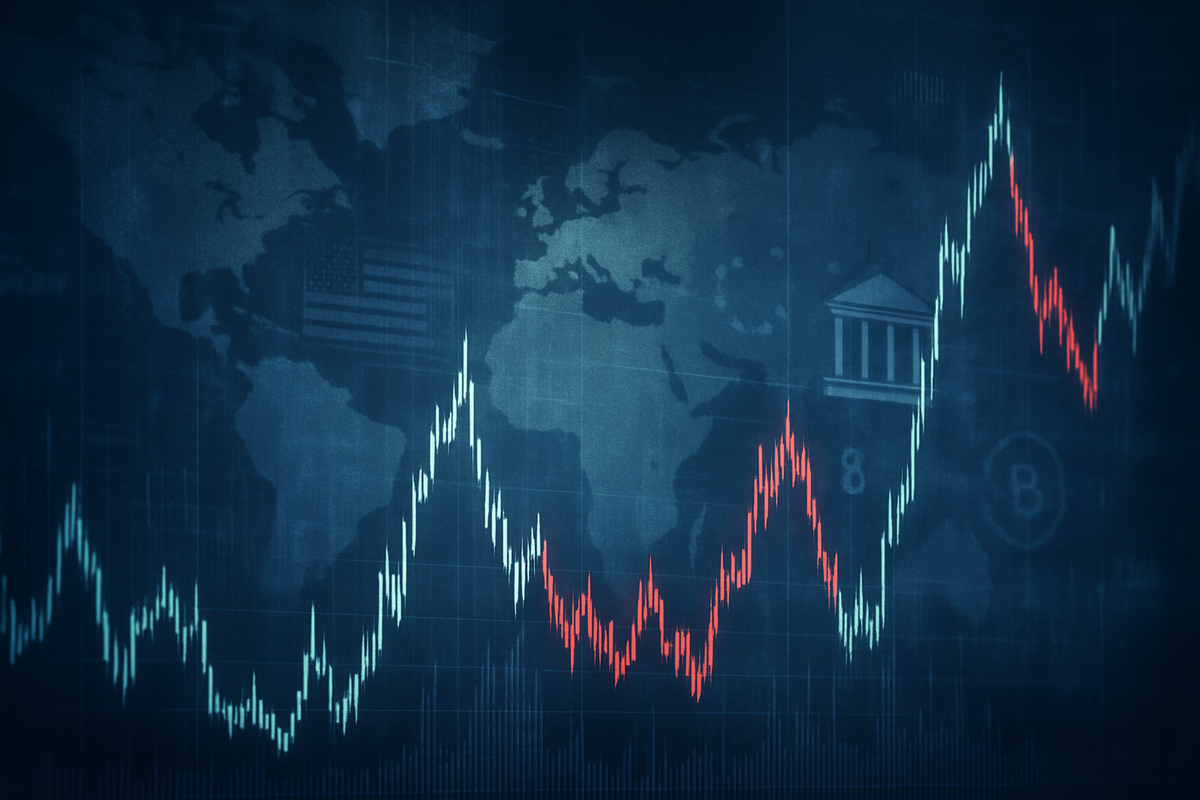
The global financial markets are once again grappling with a significant uptick in volatility, as the CBOE Volatility Index (VIX), often dubbed Wall Street's "fear gauge," experienced a dramatic surge in early October 2025. This sudden jolt, driven by renewed geopolitical tensions and domestic fiscal concerns, has sent ripples through investor sentiment, prompting a visible shift towards risk aversion and hedging strategies, as reflected in the performance of leveraged volatility exchange-traded funds (ETFs). The current elevated VIX levels, hovering around 20, suggest that while outright panic is not pervasive, a palpable sense of caution and uncertainty has taken hold, compelling investors to re-evaluate their portfolios and brace for potential further market fluctuations.
The Fear Gauge Flashes Red: A Detailed Look at October's Volatility Surge
The month of October 2025 has been marked by a notable re-emergence of market volatility, culminating in a significant VIX spike that underscored underlying investor anxieties. As of October 16, 2025, the VIX closed around 20.31, having traded near 20.64 earlier in the day. This level is considerably higher than what is typically observed during periods of market complacency, signaling a clear shift towards a more cautious investment posture.
The most impactful event was a dramatic surge on Friday, October 10, 2025. The VIX soared by an astonishing 25.68% to 20.65, with some reports indicating an even steeper climb to $21.66, representing a 31.83% increase from its previous close of 16.43 on October 9. This marked the largest single-day jump for the volatility index in over six months, immediately drawing comparisons to prior periods of intense market stress. The primary catalyst for this sudden market unease was a sharp escalation in U.S.-China trade tensions, following threats of "massive increases of tariffs" from President Trump. This geopolitical tremor was compounded by persistent domestic fiscal anxieties and an ongoing U.S. government shutdown, creating a potent cocktail of uncertainty that rattled investor confidence.
Leveraged ETFs designed to capitalize on or hedge against volatility movements reacted swiftly. The ProShares Ultra VIX Short-Term Futures ETF (UVXY), which offers 1.5x leveraged exposure to short-term VIX futures, saw its price increase by 19.07% on October 10, rising from $10.49 to $12.49, with daily fluctuations reaching 22.25%. Over the two weeks leading up to October 10, UVXY registered a gain of 20.79%, highlighting its role as a key instrument for investors seeking to profit from or hedge against rising volatility. Conversely, the ProShares Short VIX Short-Term Futures ETF (SVXY), which aims for 0.5x inverse exposure, likely experienced declines, although specific daily performance data around the spike for SVXY was less detailed in available reports. The overall movement, however, indicates a significant unwinding of previously held short-volatility positions. Further reinforcing the cautious outlook, on October 16, 2025, the VIX futures curve inverted, a classic sign of short-term stress, indicating that investors are paying a premium for immediate protection. The VVIX (volatility of volatility) also remained above 120, signaling strong demand for hedging through VIX options.
Companies Navigating the Volatility: Winners and Losers
The recent surge in market volatility, as indicated by the VIX, creates a bifurcated landscape for public companies, presenting both significant challenges and unique opportunities. Companies whose business models are highly sensitive to economic stability, consumer confidence, and international trade relations are particularly vulnerable, while those positioned to benefit from market uncertainty or providing hedging solutions may see gains.
Companies with significant exposure to international trade, particularly those involved in U.S.-China commerce, stand to lose the most from the renewed tariff threats. Large multinational corporations in sectors like technology, manufacturing, and consumer goods, such as Apple Inc. (NASDAQ: AAPL), Boeing Co. (NYSE: BA), and Nike Inc. (NYSE: NKE), often rely on complex global supply chains and access to vast international markets. Increased tariffs could disrupt their production, raise input costs, and dampen demand, directly impacting their profitability and stock performance. Furthermore, companies with high debt loads or those heavily reliant on stable credit markets might face increased borrowing costs if volatility translates into tighter financial conditions.
Conversely, certain sectors and companies may find themselves in a more favorable position. Providers of volatility-linked investment products, such as ProShares (Private), the issuer of UVXY and SVXY, benefit from increased trading volumes and investor interest in these hedging instruments during periods of market turbulence. Brokerage firms and financial institutions that facilitate options trading and risk management services could also see an uptick in activity. Furthermore, companies with robust balance sheets, strong domestic focus, or those operating in defensive sectors like utilities or consumer staples, such as NextEra Energy Inc. (NYSE: NEE) or Procter & Gamble Co. (NYSE: PG), might be perceived as safer havens by investors fleeing risk, potentially leading to increased demand for their shares. The current environment also favors companies offering software or services that help other businesses manage supply chain disruptions or navigate regulatory changes, as demand for such solutions tends to rise during periods of uncertainty.
Broader Implications: Geopolitics, Fiscal Policy, and Market Structure
The recent VIX spike and the ensuing market caution are not isolated incidents but rather critical indicators reflecting broader industry trends and systemic risks. The interplay of escalating geopolitical tensions, domestic fiscal uncertainties, and the structural dynamics of modern financial markets is creating a complex environment for investors and policymakers alike.
The renewed U.S.-China trade dispute serves as a stark reminder of the persistent threat that geopolitics poses to global economic stability. This event fits into a larger trend of increasing economic nationalism and protectionist policies, which have been a recurring theme over the past few years. Such actions can lead to fragmented global supply chains, increased production costs, and reduced international trade volumes, ultimately dampening global economic growth. The ripple effects extend beyond direct trade partners, impacting commodity markets, currency valuations, and investor confidence worldwide. Furthermore, the ongoing U.S. government shutdown and persistent fiscal anxieties highlight the fragility of domestic policy-making and its immediate impact on market sentiment. A lack of fiscal clarity can undermine business investment, consumer spending, and overall economic predictability, making investors more prone to risk aversion.
Historically, significant VIX spikes, such as those seen in April 2025 (to 65.73 during a previous tariff crisis) or earlier in 2024 (to 62.27 on recession signals), have often been followed by market rebounds, sometimes viewed as "healthy market flushes" that clear out excess leverage. However, the current environment feels different, characterized by a confluence of factors rather than a single dominant crisis. Regulatory bodies are likely to scrutinize the functioning of volatility-linked products and their potential to amplify market movements during stress events, potentially leading to calls for increased transparency or stricter oversight of leveraged ETFs. The high VVIX and inverted VIX futures curve also underscore a structural shift in how investors are approaching risk, increasingly using sophisticated derivatives for hedging rather than simply reacting to events. This proactive hedging could, in turn, contribute to more rapid price discovery during periods of uncertainty, but also potentially exacerbate short-term movements.
What Comes Next: Navigating the Uncertain Path Ahead
The elevated VIX and the cautious market sentiment it reflects point to a period of continued vigilance and strategic adaptation for investors and companies alike. The immediate future will likely be shaped by developments on several fronts, dictating both short-term market movements and long-term strategic pivots.
In the short term, the market's trajectory will heavily depend on the resolution, or lack thereof, of the U.S.-China trade tensions and the U.S. government's fiscal situation. Any de-escalation of trade rhetoric or a swift end to the government shutdown could provide a temporary boost to market confidence, potentially leading to a moderation in the VIX. Conversely, further escalation or prolonged political deadlock would likely keep volatility elevated, prompting continued demand for hedging instruments and potentially triggering further market corrections. Companies may need to accelerate their contingency planning, diversifying supply chains away from heavily tariffed regions or focusing on domestic markets to mitigate risks. Investors should anticipate continued price swings and be prepared for rapid shifts in sentiment based on news headlines.
Looking further ahead, this period of heightened volatility may force a more fundamental reassessment of global trade policies and corporate supply chain resilience. Companies that successfully adapt by diversifying their manufacturing bases, exploring new markets, or innovating to reduce reliance on vulnerable inputs will emerge stronger. Market opportunities may arise in sectors that offer stability or provide solutions to the challenges posed by geopolitical fragmentation, such as cybersecurity, automation, and domestic infrastructure development. Potential strategic pivots could include increased onshoring or nearshoring of production, greater investment in R&D to foster self-sufficiency, and a renewed focus on regional trade blocs. Investors should consider increasing their allocation to defensive assets, exploring alternative investments that are less correlated with traditional equity markets, and maintaining sufficient cash reserves to capitalize on potential "buy the dip" opportunities that may arise from sharp, but temporary, market dislocations.
Comprehensive Wrap-Up: Navigating a Volatile Horizon
The recent VIX spike and the sustained elevated levels of volatility underscore a critical shift in market sentiment, moving from relative complacency to a state of heightened caution and active risk management. The dramatic 25-31% surge in the VIX on October 10, 2025, driven by renewed U.S.-China tariff threats and domestic fiscal anxieties, served as a potent reminder of the fragility of market stability in the face of geopolitical and policy uncertainties. The robust performance of leveraged volatility ETFs like UVXY during this period highlights investors' proactive embrace of hedging strategies, signaling a collective effort to protect portfolios against potential downturns.
Moving forward, the market will likely remain susceptible to external shocks, with geopolitical developments and domestic policy decisions acting as key catalysts for future movements. While some historical precedents suggest that VIX spikes can sometimes precede market rebounds, the current environment's complexity, marked by multiple interconnected stressors, warrants a more nuanced perspective. Investors should maintain a disciplined approach, prioritizing diversification, robust risk management, and a clear understanding of their investment horizons. The enduring significance of this period lies in its potential to reshape corporate strategies towards greater resilience and to ingrain a more vigilant approach among investors. What investors should watch for in the coming months are any concrete signs of de-escalation in trade tensions, progress on U.S. fiscal policy, and the sustained demand for hedging instruments, all of which will provide crucial clues about the market's path forward.
This content is intended for informational purposes only and is not financial advice






